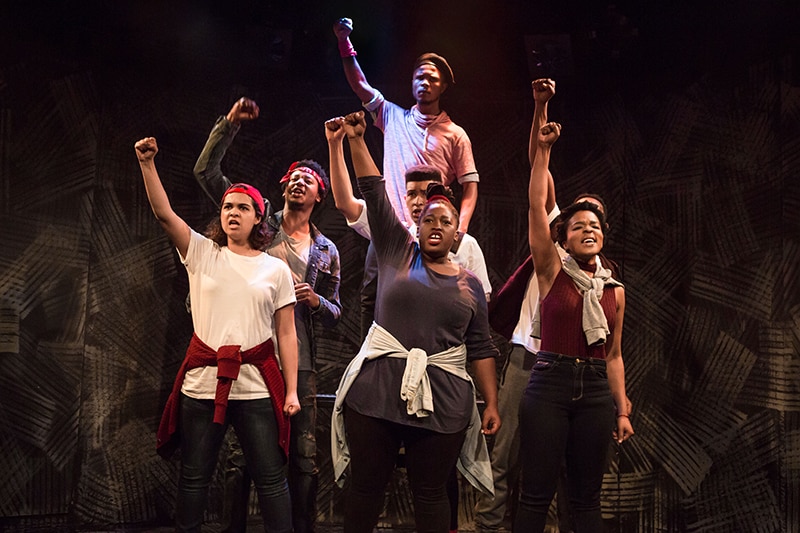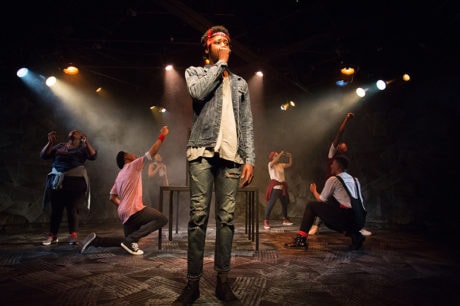A passionate purity burns bright in The Fall.
The incandescence of young people with hearts on fire contending against oppressive institutions burns bright in the 2015 South Africa portrayed in The Fall, as it did in America during the civil rights and anti-Vietnam war movements of the 1960s, and as it continues in different forms today. The show is currently playing at Studio Theatre as part of an international tour.

What gives the performance power is its immediacy. Created and staged by a group of actor/activists (Ameera Conrad, Oarabile Ditsele, Zandile Madliwa, Tankiso Mamabolo, Sizwesandile Mnisi, Shile Mnqwazana, and Cleo Raatus), the play’s feel is not that of a documentary told from a distance but of distilled, lived experience. The cast members are all professional actors and writers with impressive early career resumes, but there is nothing stagey about the work. Stories are told in the minds and hearts and bodies and voices of participants attempting to “decolonize” South African education and society.
The play originated at the University of Cape Town in response to the #RhodesMustFall student movement. The Rhodes in question was a large, prominent campus statue of Cecil Rhodes, the wealthy politician who was the founder of the De Beers diamond cartel and an outspoken proponent of British imperialism, the superiority of the white race, and the colonialist project of civilizing, while subjugating, the supposedly inferior darker-skinned peoples who had fallen under European rule.
For the activists, the statue had to go. Honoring an imperialist icon – like honoring Confederate leaders and generals here – blatantly disrespected the lives of people of color. Through means reminiscent of American protests in the 1960s and ’70s – marches, stirring and angry speeches, occupations of college administration buildings – they pushed university management into removing the statue, a celebrated victory for decolonization. But the people depicted in the play intuitively understood a point well articulated this week in a New York Times article by Algerian writer Kamel Daoud: “the decolonized must get beyond the past, and take responsibility for their present, with sincerity.” The center of the play is the question, after a symbolic victory, what’s next?
Well, what about the daily disrespect shown black and colored students, like being excluded from a cricket team because the coach did not think the player was compatible with team chemistry? What about the Eurocentric curriculum and the relative scarcity of non-white teachers? What about the low wages of university support staff whose jobs are in danger of being outsourced? What about unaffordable tuition and fees and the crushing burden of student loans? What about structural racism in its varied forms? It’s not easy for this group, as deeply committed as they are, to keep such a multifaceted movement in focus.
So internal conflicts arise. For the participants, the political is highly personal. There are sharp debates about strategy and tactics. How far to go toward direct, potentially violent, action? What’s the tradeoff between closing down the university at exam time to bring pressure on the administration and permitting medical students to graduate so as to be able to serve people in the townships?
Different experiences of race and color – South Africa is no more a binary society in racial terms than in gender terms – as well as economic circumstances create clashing perspectives. Gender roles and expectations become a center of angry contention and sometimes lead to estrangement among group members. The play’s handling of the divisions, as well as the unity of their common cause, rings very true to anyone familiar with the American civil rights and anti-war movements, as well as the present day “resistance.”
Appropriate to the material, the cast acts on a bare stage, using only a few tables as occasional set pieces, with projected sequences at key points (e.g., videos of a violent police reaction to a demonstration). The actors’ ensemble singing, encompassing the changing moods of the play, is the most important part of the soundscape, and movement elements of the staging are emotionally expressive and powerful.

The play is honest about the limits as well as the necessity of activism. A statue comes down, a fee increase is reversed, but the structure of society is not fundamentally changed. There is an emotional cost to participation.
As a character says toward the end of the play, in a line highlighted by the excellent dramaturgical material Studio has made available (I recommend reading it on their website), “I want to be seen. I want to matter. I’m tired. My soul is tired but the reasons I came the first time won’t let me leave. They won’t let me lead a normal life.”
Yet these people pass, with flying colors, a test articulated long before by Oliver Wendell Holmes Jr.: “I think that, as life is action and passion, it is required…[that one] should share the passion and action of his time at peril of being judged not to have lived.”
Running Time: 90 minutes, with no intermission.
The Fall plays through November 18, 2018, at Studio Theatre, 1501 14th Street, NW, Washington DC. For tickets, call the box office at 202-332-3300 or go online.
Note: TodayTix is running a $5 ticket lottery now through Thursday, October 18. Register here for a chance to win a $5 ticket.





Mr. Ashby, I thank you for an insightful article. I go to see the production at Studio this afternoon, and your insights intrigue me. I am very much looking forward to the production and will check out the dramaturgical material which you recommend on Studio’s website.